weight TOYOTA 86 2019 Owners Manual
[x] Cancel search | Manufacturer: TOYOTA, Model Year: 2019, Model line: 86, Model: TOYOTA 86 2019Pages: 532, PDF Size: 6.89 MB
Page 51 of 532
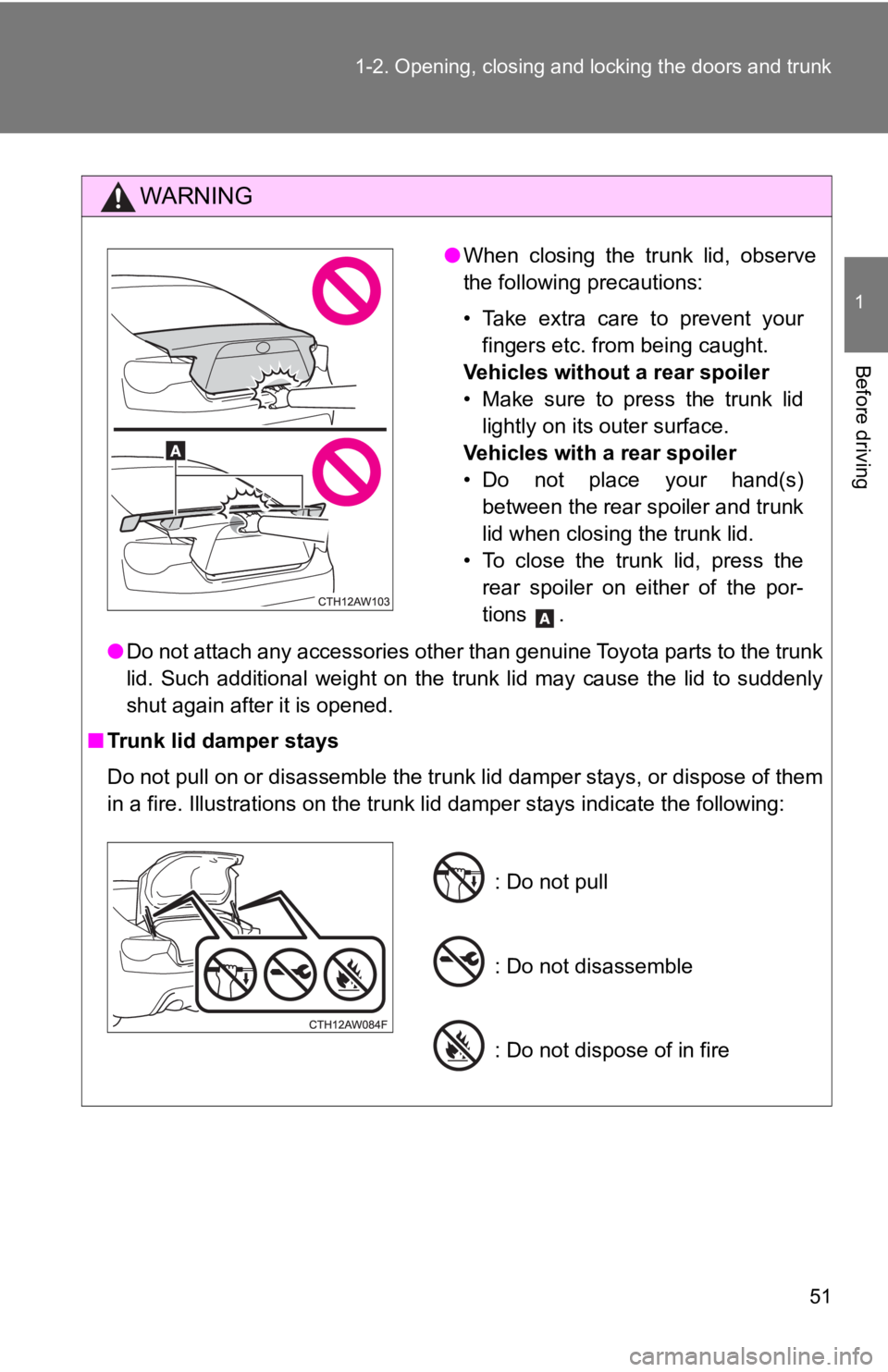
511-2. Opening, closing and locking the doors and trunk
1
Before driving WARNING
● Do not attach any accessories other than genuine Toyota parts t o the trunk
lid. Such additional weight on the trunk lid may cause the lid to suddenly
shut again after it is opened.
■ Trunk lid damper stays
Do not pull on or disassemble the trunk lid damper stays, or di spose of them
in a fire. Illustrations on the trunk lid damper stays indicate the following:● When closing the trunk lid, observe
the following precautions:
• Take extra care to prevent your
fingers etc. from being caught.
Vehicles without a rear spoiler
• Make sure to press the trunk lid
lightly on its outer surface.
Vehicles with a rear spoiler
• Do not place your hand(s)
between the rear spoiler and trunk
lid when closing the trunk lid.
• To close the trunk lid, press the
rear spoiler on either of the por-
tions .
: Do not pull
: Do not disassemble
: Do not dispose of in fire
Page 92 of 532
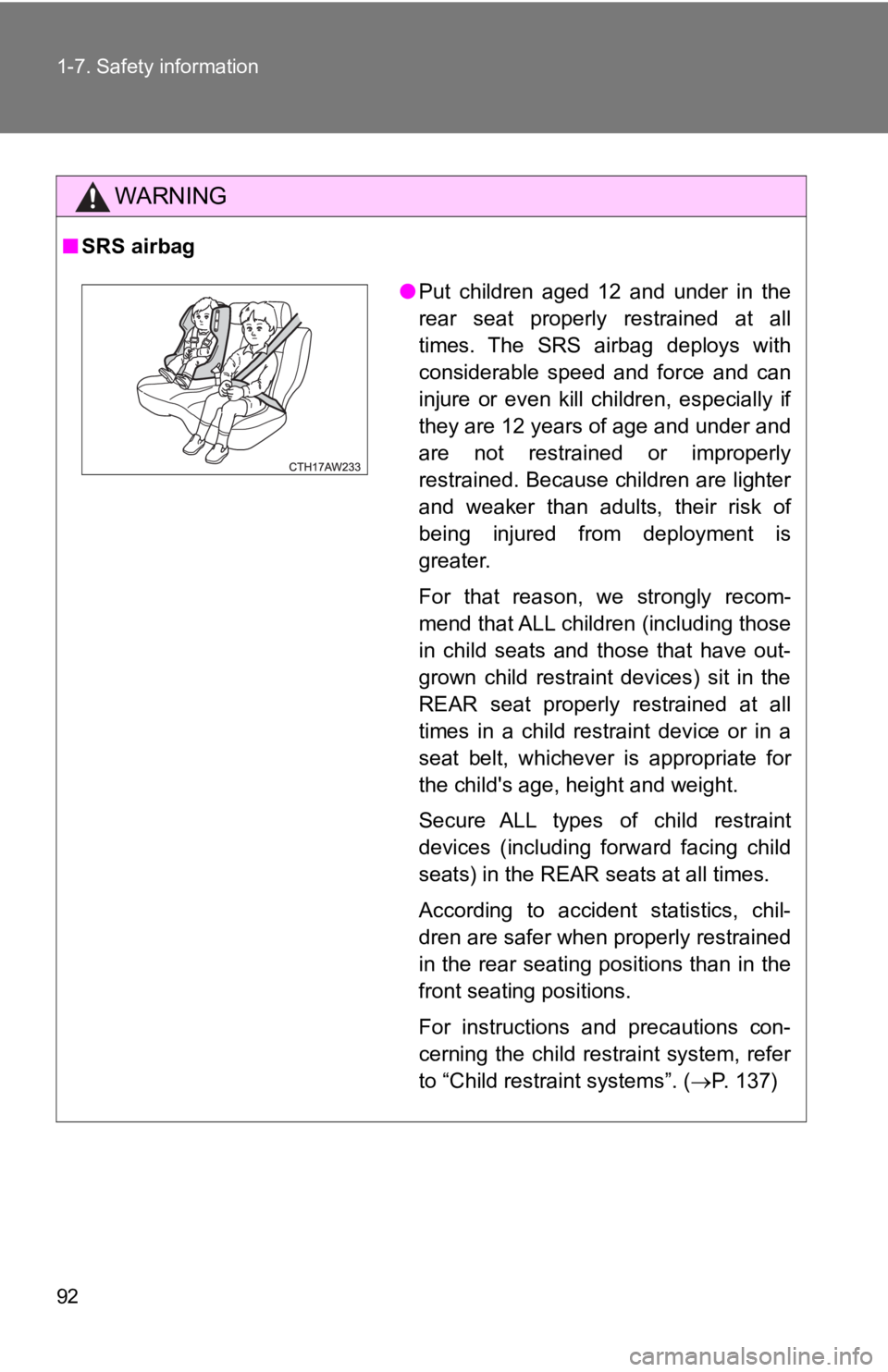
921-7. Safety information
WARNING■ SRS airbag
● Put children aged 12 and under in the
rear seat properly restrained at all
times. The SRS airbag deploys with
considerable speed and force and can
injure or even kill children, especially if
they are 12 years of age and under and
are not restrained or improperly
restrained. Because children are lighter
and weaker than adults, their risk of
being injured from deployment is
greater.
For that reason, we strongly recom-
mend that ALL children (including those
in child seats and those that have out-
grown child restraint devices) sit in the
REAR seat properly restrained at all
times in a child restraint device or in a
seat belt, whichever is appropriate for
the child's age, height and weight.
Secure ALL types of child restraint
devices (including forward facing child
seats) in the REAR seats at all times.
According to accident statistics, chil-
dren are safer when properly restrained
in the rear seating positions than in the
front seating positions.
For instructions and precautions con-
cerning the child restraint system, refer
to “Child restraint systems”. ( P. 137)
Page 256 of 532
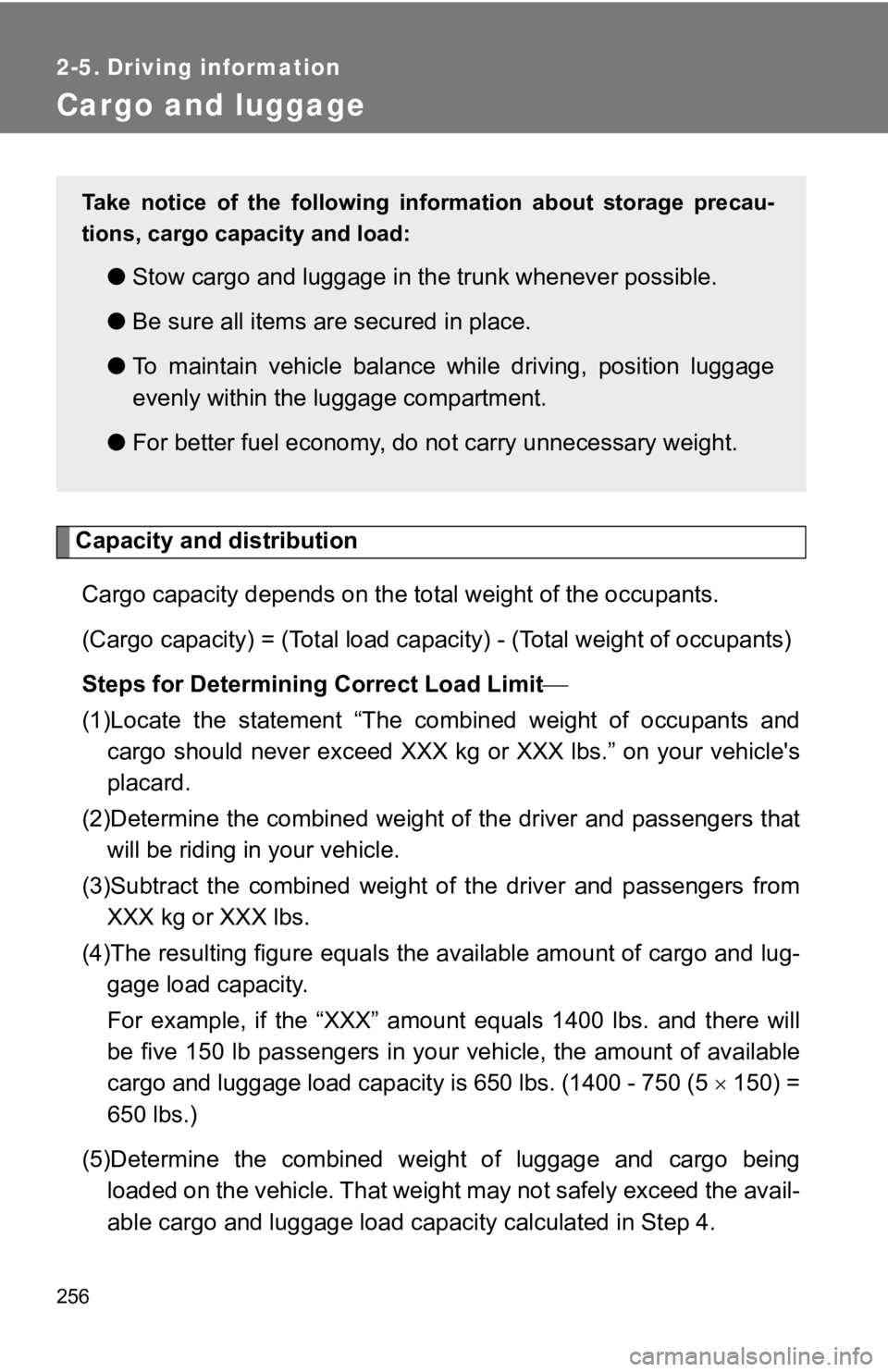
2562-5. Driving information
Cargo and luggage
Capacity and distribution
Cargo capacity depends on the to tal weight of the occupants.
(Cargo capacity) = (Tot al load capacity) - (Total weight of occ upants)
Steps for Determini ng Correct Load Limit
(1)Locate the statement “The co mbined weight of occupants and
cargo should never exceed XXX kg or XXX lbs.” on your vehicle's
placard.
(2)Determine the combined weight of the driver and passengers t hat
will be riding in your vehicle.
(3)Subtract the combined weight of the driver and passengers fr om
XXX kg or XXX lbs.
(4)The resulting figure equals the available amount of cargo and lug-
gage load capacity.
For example, if the “XXX” amount equals 1400 lbs. and there wil l
be five 150 lb passengers in your vehicle, the amount of availa ble
cargo and luggage load capacity is 650 lbs. (1400 - 750 (5 150) =
650 lbs.)
(5)Determine the combined wei ght of luggage and cargo being
loaded on the vehicle. That weight may not safely exceed the av ail-
able cargo and luggage load ca pacity calculated in Step 4.Take notice of the following information about storage precau-
tions, cargo capacity and load:
● Stow cargo and luggage in t he trunk whenever possible.
● Be sure all items are secured in place.
● To maintain vehicle balance while driving, position luggage
evenly within the luggage compartment.
● For better fuel economy, do no t carry unnecessary weight.
Page 257 of 532
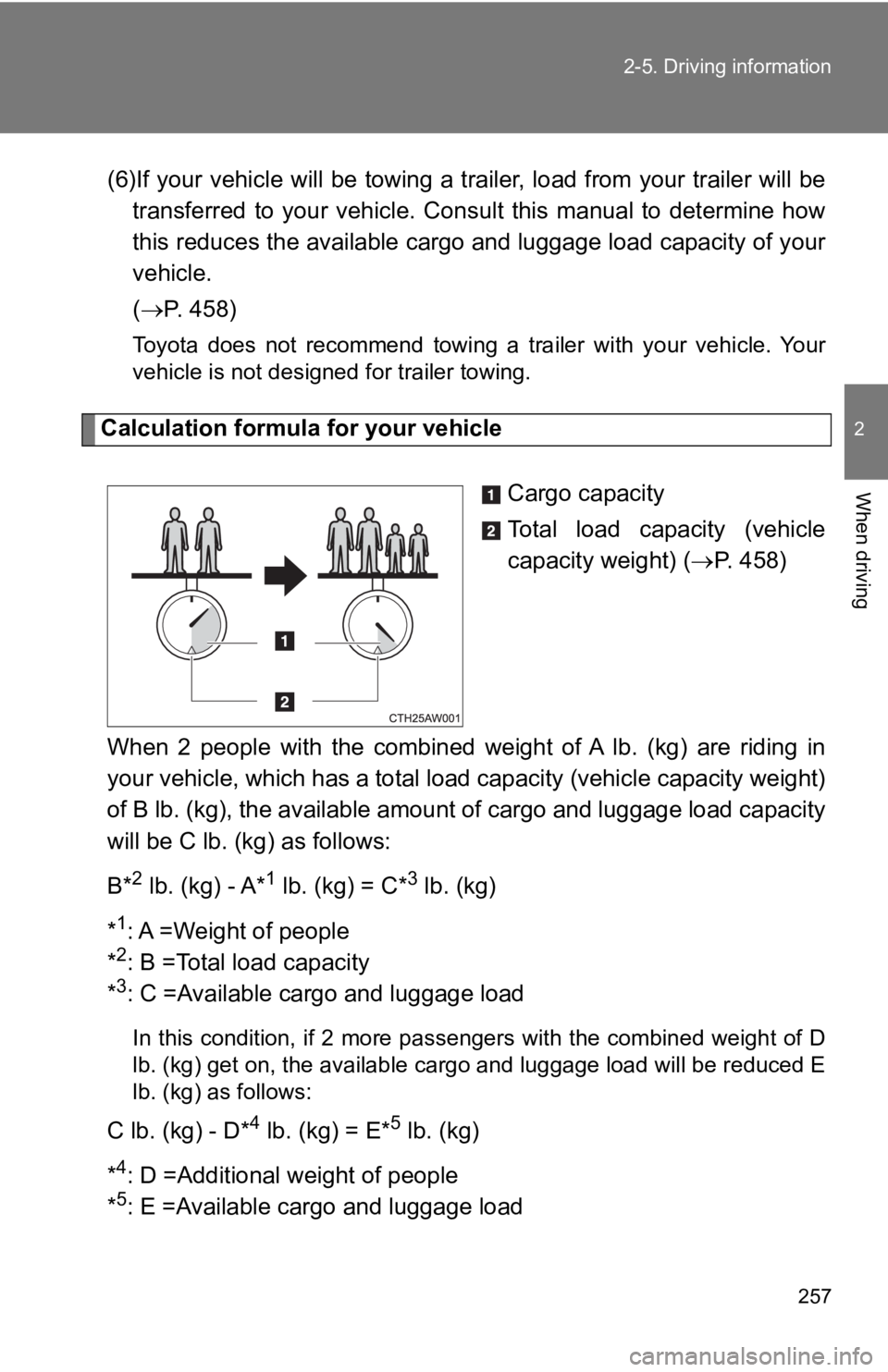
2572-5. Driving information
2
When driving (6)If your vehicle will be towing a trailer, load from your tra iler will be
transferred to your vehicle. Cons ult this manual to determine h ow
this reduces the available cargo and luggage load capacity of y our
vehicle.
( P. 458)Toyota does not recommend towing a trailer with your vehicle. Y our
vehicle is not designed for trailer towing.
Calculation formula for your vehicle
Cargo capacity
Total load capacity (vehicle
capacity weight) ( P. 458)
When 2 people with the combined weight of A lb. (kg) are riding in
your vehicle, which has a total load capacity (vehicle capacity weight)
of B lb. (kg), the available amount of cargo and luggage load c apacity
will be C lb. (kg ) as follows:
B* 2
lb. (kg) - A* 1
lb. (kg) = C* 3
lb. (kg)
* 1
: A =Weight of people
* 2
: B =Total load capacity
* 3
: C =Available cargo and luggage load
In this condition, if 2 more passengers with the combined weigh t of D
lb. (kg) get on, the available cargo and luggage load will be r educed E
lb. (kg) as follows:
C lb. (kg) - D* 4
lb. (kg) = E* 5
lb. (kg)
* 4
: D =Additional we ight of people
* 5
: E =Available cargo and luggage load
Page 258 of 532

2582-5. Driving information
As shown in the example above, if the number of occupants
increases, the cargo and luggage load will be reduced by an amo unt
that equals the increased weig ht due to the additional occupant s. In
other words, if an increase in t he number of occupants causes a n
excess of the total load capacit y (combined weight of occupants plus
cargo and luggage load), you must reduce the cargo and luggage on
your vehicle.
WARNING■
Things that must not be carried in the trunk
The following things may cause a fire if loaded in the trunk:●
Receptacles containing gasoline●
Aerosol cans
Page 259 of 532

2592-5. Driving information
2
When driving WARNING■
Storage precautions
Observe the following precautions.
Failure to do so may result i n death or serious injury.●
Stow cargo and luggage in the trunk whenever possible.●
To prevent cargo and luggage from sliding forward during brakin g, do
not stack anything in the enlarged trunk. Keep cargo and luggag e low,
as close to the floor as possible.●
When you fold down the rear seats, long items should not be pla ced
directly behind the front seats.●
Never allow anyone to ride in the enlarged trunk. It is not des igned for
passengers. They should ride in their seats with their seat bel ts prop-
erly fastened. Otherwise, they are much more likely to suffer d eath or
serious bodily injury, in the event of sudden braking, sudden s werving
or an accident.
●
Do not place cargo or luggage in or on the following locations as the
item may get under the clutch, brake or accelerator pedal and p revent
the pedals from being depressed properly, block the driver’s vi sion, or
hit the driver or passengers, causing an accident:
• At the feet of the driver
• On the front passenger or rear seats (when stacking items)
• On the package tray
• On the instrument panel
• On the dashboard
●
Secure all items in the occupant compartment, as they may shift and
injure someone during sudden braking, sudden swerving or an acc i-
dent.
■
Capacity and distribution
●
Do not exceed the maximum axle weight rating or the total vehic le
weight rating.
●
Even if the total load of occupant's weight and the cargo load is less
than the total load capacity, do not apply the load unevenly. I mproper
loading may cause deterioration of steering or braking control which
may cause death or serious injury.
Page 260 of 532
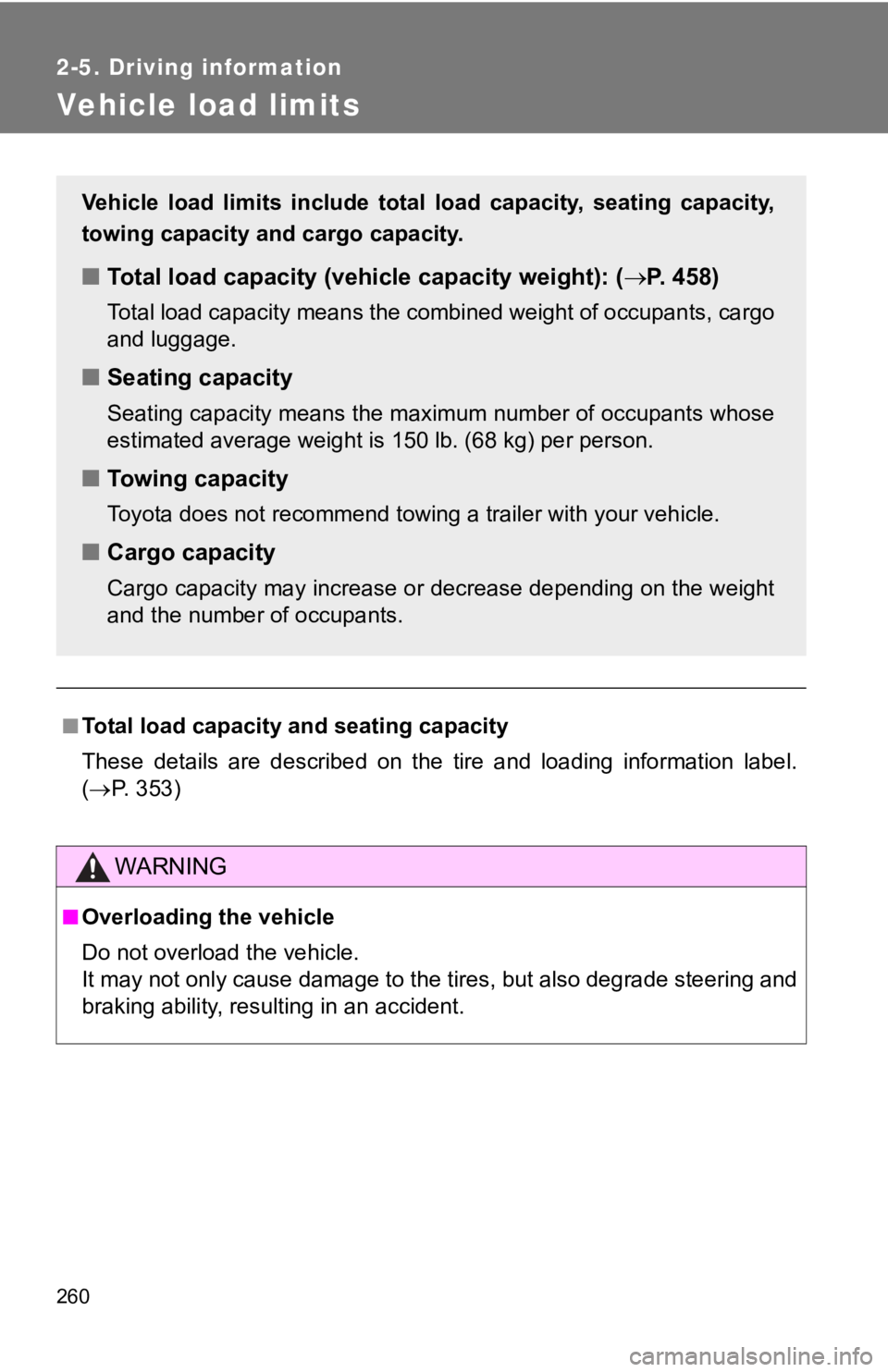
2602-5. Driving information
Vehicle load limits
■
Total load capacity and seating capacity
These details are described on the tire and loading information label.
( P. 3 5 3 )
WARNING
■
Overloading the vehicle
Do not overload the vehicle.
It may not only cause damage to t he tires, but also degrade ste ering and
braking ability, resulting in an accident. Vehicle load limits include total load capacity, seating capaci ty,
towing capacity and cargo capacity.
■ Total load capacity (veh icle capacity weight): ( P. 458)Total load capacity means the combined weight of occupants, car go
and luggage.
■ Seating capacity Seating capacity means the max imum number of occupants whose
estimated average weight is 150 lb. (68 kg) per person.
■ Towing capacity Toyota does not recommend towing a trailer with your vehicle.
■ Cargo capacity Cargo capacity may increase or decrease depending on the weight
and the number of occupants.
Page 328 of 532

3284-3. Do-it-yourself maintenance
WARNING■ Pre-driving check
Check that the hood is fully closed and locked.
If the hood is not locked properly it may open while the vehicl e is in motion
and cause an accident, which may result in death or serious inj ury.
NOTICE■ When opening the hood
● Do not lift up or operate the wipers. Doing so may cause the ho od and wip-
ers to contact, scratching the hood.
● Use caution when opening the hood in windy weather as it may close sud-
denly in strong wind.
● Do not attach any accessories other than genuine Toyota product s to the
hood. Such additional weight on the hood may cause it to be too heavy to
be supported by the supporting rod when opened.
■ When closing the hood
Do not apply excessive weight or force when closing the hood as doing so
may result in damage.
Page 348 of 532
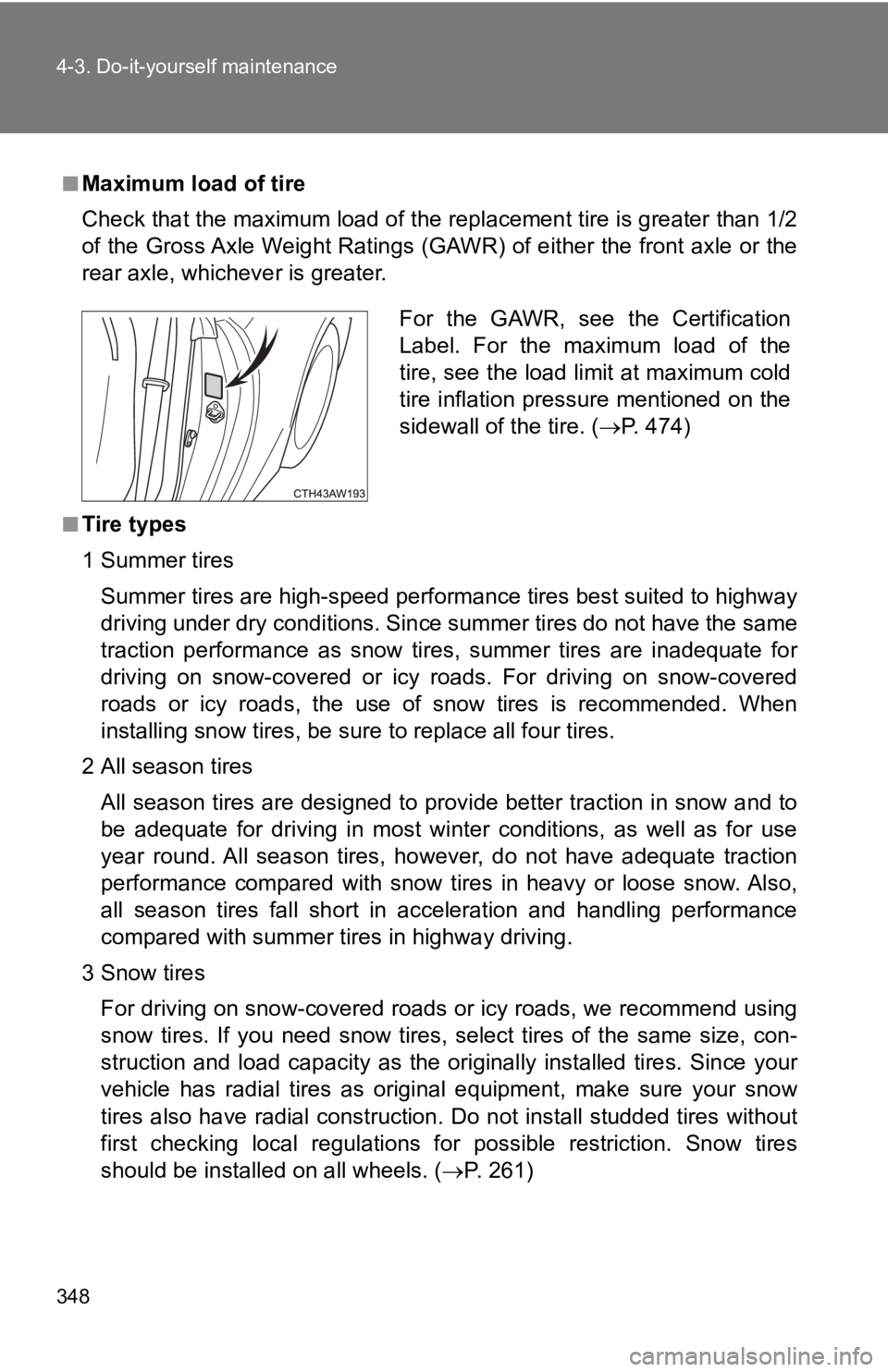
3484-3. Do-it-yourself maintenance
■
Maximum load of tire
Check that the maximum load of the replacement tire is greater than 1/2
of the Gross Axle Weight Ratings (GAWR) of either the front axl e or the
rear axle, whichever is greater.
■
Tire types
1 Summer tires
Summer tires are high-speed performance tires best suited to hi ghway
driving under dry conditions. Since summer tires do not have th e same
traction performance as snow tires, summer tires are inadequate for
driving on snow-covered or icy roads. For driving on snow-cover ed
roads or icy roads, the use of snow tires is recommended. When
installing snow tires, be sure to replace all four tires.
2 All season tires
All season tires are designed to provide better traction in sno w and to
be adequate for driving in most winter conditions, as well as f or use
year round. All season tires, however, do not have adequate tra ction
performance compared with snow tires in heavy or loose snow. Al so,
all season tires fall short in acceleration and handling perfor mance
compared with summer tires in highway driving.
3Snow tires
For driving on snow-covered roads or icy roads, we recommend us ing
snow tires. If you need snow tires, select tires of the same si ze, con-
struction and load capacity as th e originally installed tires. Since your
vehicle has radial tires as original equipment, make sure your snow
tires also have radial construction. Do not install studded tir es without
first checking local regulations for possible restriction. Snow tires
should be installed on all wheels. ( P. 261)For the GAWR, see the Certification
Label. For the maximum load of the
tire, see the load limit at maximum cold
tire inflation pressure mentioned on the
sidewall of the tire. ( P. 4 7 4 )
Page 355 of 532

3554-3. Do-it-yourself maintenance
4
Maintenance and care ■
Effects of inco rrect tire inflation pressure
Driving with incorrect tire inflation pressure may result in th e following:●
Reduced fuel economy●
Reduced driving comfort and poor handling●
Reduced tire life due to wear●
Reduced safety●
Damage to the drive train
If a tire needs frequ ent refilling, have it checked by your Toy ota dealer.■
Instructions for checking tire inflation pressure
When checking tire inflation pressure, observe the following: ●
Check only when the tires are cold.
If your vehicle has been parked fo r at least 3 hours and has no t been
driven for more than 1 mile or 1.5 km, you will get an accurate cold
tire inflation pressure reading.
●
Always use a tire pressure gauge.
It is difficult to judge if a tir e is properly inflated based o nly on its
appearance.
●
It is normal for the tire inflation pressure to be higher after driving as
heat is generated in the tire. Do not reduce tire inflation pre ssure after
driving.
●
Never exceed the vehicle capacity weight.
Passengers and luggage weight should be placed so that the vehi cle
is balanced.